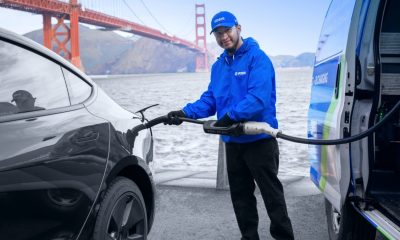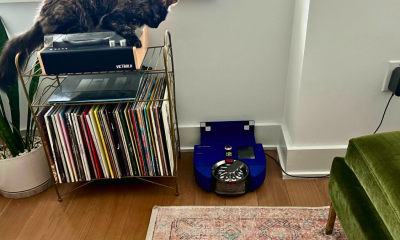Technology
14 innovations that helped make the world a better place in 2018

People across the world may face a variety of challenges, but innovators, activists, and organizations worked together in 2018 to find impressive solutions.
In no particular order, here are 14 innovations that made the world a more inclusive, safe, and all-around better place this year. To learn about other ingenious innovations, check out this list from 2017.
1. Starbucks signing store in U.S.
You can get these mugs at Starbucks’ first U.S. Signing Store in Washington D.C.
Image: Joshua Trujillo / Starbucks
Starbucks opened its first U.S. store for Deaf and hard-of-hearing customers in Washington, D.C. The cafe’s employees are proficient in American Sign Language and wear aprons with fingerspelling. The store also teaches non-ASL speakers fingerspelling through digital notepads and chalkboard messages. Starbucks’ first-ever “signing” store opened in Malaysia a few years ago, but the D.C. location introduces the concept to American consumers. It also draws attention to how many public spaces are not accessible to people with disabilities while simultaneously demonstrating how they can be reimagined to serve everyone. — Victoria Rodriguez
2. A benefits platform for domestic workers
People who clean homes for a living typically don’t have any job benefits. promises to change that for millions of people, most of whom are women. The platform, launched this year by the National Domestic Workers Alliance, makes it possible for workers to request and receive contributions from their clients. Benefit options include accident insurance, paid time off, and life insurance. Clients can contribute as little as $5 per cleaning to help their cleaner get benefits. — Rebecca Ruiz
3. An armband that helps diagnose malnutrition
The IRC’s armband, adapted for use by low-literate community health workers, in action.
Image: Elburg van Boetzelaer / International Rescue Committee
Humanitarian workers have long relied on simple armbands to measure malnutrition in remote parts of the world. The typical armband is tri-colored and includes numbers that allow workers to gauge whether a child is experiencing significant weight loss related to malnutrition. Those children are then referred to far-off treatment centers that they may not be able to reach. This year, the International Rescue Committee completed research on a new version of this tool. The design included removing the numbers and adding two additional colors so that low-literate community health workers can visually monitor progress of treatment and weight gain. That means local providers can diagnose and treat malnutrition without help from humanitarian workers. Promising results from the pilot in South Sudan saw higher numbers of severely malnourished children treated than at a health facility. — Rebecca Ruiz
4. An expo for sanitation technology

Bill Gates gives a speech during the “reinvented toilet expo” in Beijing on November 6, 2018.
Image: NICOLAS ASFOURI/AFP/Getty Images
The Bill and Melinda Gates Foundation launched the Reinvented Toilet Expo in Beijing, China, to showcase cutting-edge sanitation products from around the world. An estimated younger than 5 years old die from diarrhea each year, which in part, can be with safe drinking water and access to hygiene and sanitation. Toilets featured at the expo eliminate pathogens and turn waste into clean water and fertilizer. They can do so without sewer or water lines, which is crucial for countries that don’t have adequate sewer systems. — Victoria Rodriguez
5. Xbox adaptive controller

An Xbox controller that can be adapted for someone with limited mobility.
Image: DUSTIN DRANKOSKI / MASHABLE
This Xbox controller was designed to meet the needs of gamers who have limited mobility. Gamers can customize the controller by attaching switches, joysticks, and other external devices. It also features larger buttons and rubberized stabilizers, making it easier to put the controller on a person’s lap or table. — Victoria Rodriguez
6. Code for America clears marijuana convictions

A year after recreational marijuana in November 2016, the nonprofit organization Code for America decided to use its Clear My Record program to help people expunge marijuana-related criminal offenses from their record. In May 2018, it partnered with the to clear felony marijuana convictions from people’s records. Code for America, which helps the government connect with communities through technology, hopes to clear 250,000 marijuana convictions by 2019.— Victoria Rodriguez
7. A new taxonomy for language about sexual violence at work

Image: NSVRC/ the Urban Institute / uber

Image: NSVRC/ THE URBAN INSTITUTE / UBER
This from National Sexual Violence Resource Center and Urban Institute created improved ways of categorizing reports of sexual harassment, sexual misconduct, and sexual assault that happen at work. In a big move for a company notoriously plagued with sexual misconduct in the workplace, Uber provided NSVRC and the Urban Institute with internal reports and data to inform the taxonomy. Though the white paper is specific to Uber, the overarching goal is to better categorize and organize reports so companies can eventually prevent workplace harassment or worse. — Sasha Lekach
8. Using Alexa to donate to charity

Although Amazon’s Alexa has about privacy and hackers, the device can be used for good. With a voice command, you can donate between $5 and $5,000 to select . — Victoria Rodriguez
9. New emoji for people with disabilities

Apple worked with disability organizations, including , the , and the , to propose 13 new emoji to Unicode Consortium, the nonprofit organization that green-lights new emoji. The designs promote inclusion and represent people with disabilities. They include a person in mechanized wheelchair, an ear with hearing aid, a service dog with vest and leash, and more. Unicode Consortium is currently considering the emoji for approval. — Victoria Rodriguez
10. An initiative to collect data to help refugees

Displaced Syrian children at the camp “Hope” in the Syrian village of Kafr Lusein on September 13, 2018.
Image: OMAR HAJ KADOUR / AFP / Getty Images
In response to the refugee crisis, the United Nations Refugee Agency and the World Bank Group established the Joint Data Center on Forced Displacement, a new center to collect, analyze, and share data about refugees, regarding gender, age, income, and other socioeconomic information. The information will help host countries, aid organizations, and policymakers better assist refugees and meet their specific needs. — Victoria Rodriguez
11. Gender-neutral shopping floor

A display rack for any gender.
Image: © Svante Gullichsen Photography
The large Finnish department store Stockmann built a new floor between the men’s and women’s clothing sections: a gender-neutral shopping floor on the 1.5th floor called One Way. While just a concept, it pushes the norms of the traditional shopping mall experience. The floor offers clothing from various brands like Calvin Klein and Marimekko, and items aren’t intended for a specific gender but can be worn by anyone. — Sasha Lekach
12. Massive 3D printer that can construct a house

New Story, a nonprofit based in Silicon Valley, partnered with the construction technology company ICON to create a 3D printer that can produce a home in one day. The printer can manufacture at least 1,000 homes over its lifetime. The nonprofit hopes to support families living in extreme poverty, and it plans to build the first 3D-printed homes in El Salvador in 2019 . A home with bedrooms, a kitchen, and a bathroom costs only $4,000 to make. — Victoria Rodriguez
13. 3D “organ on a chip”

This is what a 3D “organ on a chip” looks like.
In October, researchers announced in the journal that they’d created a 3D “organ on a chip.” The bioelectronic device makes it possible for cells to grow in three dimensions. Scientists have long used petri dishes to culture cells for experiments and testing. But that two-dimensional environment doesn’t sufficiently mimic the human cell environment and has yielded misinformation as well as drug failure in clinical trials. The researchers plan to use their device to create a “gut on a chip” device and attach it to a “brain on a chip” to study the relationship between the gut microbiome and brain functioning. — Rebecca Ruiz
14. Dual-purpose car mat that provides sidewalk accessibility

Image: Ford Brazil / GTB Brazil / Code Studio
Most cars have trunk and floor mats that we take for granted. But in Brazil, the Ford EcoSport was redesigned this year to include a multi-functional trunk mat. It can be used as an accessibility mat for drivers who use a wheelchair or other mobility vehicles outside their car. The mat can be pulled from the trunk and folded away into the wheelchair to make it up curbs and other difficult terrain. The mat is also “smart” and includes a sensor that maps an area’s accessibility. Every time the mat is deployed, it sends a signal to the user’s phone, eventually gathering enough widespread data that is aggregated to inform cities and advocacy groups about public places that need improved access. — Sasha Lekach

!function(f,b,e,v,n,t,s){if(f.fbq)return;n=f.fbq=function(){n.callMethod?
n.callMethod.apply(n,arguments):n.queue.push(arguments)};if(!f._fbq)f._fbq=n;
n.push=n;n.loaded=!0;n.version=’2.0′;n.queue=[];t=b.createElement(e);t.async=!0;
t.src=v;s=b.getElementsByTagName(e)[0];s.parentNode.insertBefore(t,s)}(window,
document,’script’,’https://connect.facebook.net/en_US/fbevents.js’);
fbq(‘init’, ‘1453039084979896’);
if (window._geo == ‘GB’) {
fbq(‘init’, ‘322220058389212’);
}
if (window.mashKit) {
mashKit.gdpr.trackerFactory(function() {
fbq(‘track’, “PageView”);
}).render();
}
-

 Business4 days ago
Business4 days agoAPI startup Noname Security nears $500M deal to sell itself to Akamai
-

 Business6 days ago
Business6 days agoYoshi Mobility has come a long way since gassing up cars on the side of the road
-

 Entertainment4 days ago
Entertainment4 days agoHow to watch ‘Argylle’: When and where is it streaming?
-

 Entertainment3 days ago
Entertainment3 days agoNASA discovered bacteria that wouldn’t die. Now it’s boosting sunscreen.
-

 Business4 days ago
Business4 days agoUS think tank Heritage Foundation hit by cyberattack
-

 Entertainment3 days ago
Entertainment3 days agoDyson 360 Vis Nav robot vacuum review: Dyson should just stick to upright vacuums
-

 Business3 days ago
Business3 days agoTesla drops prices, Meta confirms Llama 3 release, and Apple allows emulators in the App Store
-

 Entertainment4 days ago
Entertainment4 days agoCrypto and taxes: Which forms you need to file





















